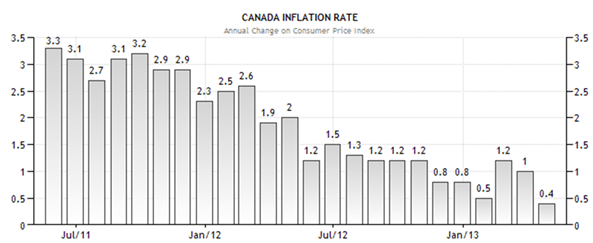Reference no: EM13257
On a graph, this is demonstrated by a series of hills and valleys corresponding to the expansion and contraction of business activity.
Business Cycle: Hills and Valleys
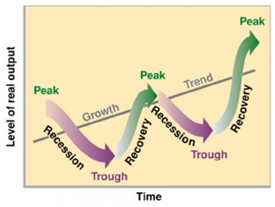
GDP (Gross Domestic Product) is the total value of all consumer goods produced within Canada during a given period. It adds up all consumer spending, investments, government spending, and net exports to find the total amount of money spent on goods and services. If the economy is growing at a significant pace, corporate profits will rise thereby causing our equity values to increase. This would be the expansion phase of the business cycle. If, on the other hand, economic growth was contracting, the reverse would be expected to occur.
The Four Stages of the Business Cycle:
1. Expansion: The period of expansion occurs when output (real GDP) is rising significantly. Usually during the expansion phase, unemployment is falling and both consumer and business confidence is high. Interest rates and inflation are also low as consumer confidence rises. Investment spending by firms is rising, as well as expenditures for expensive durable consumer goods, such as automobiles and household appliances.
2. Peak: The point in time when the expansion comes to an end, when output is at the highest point in the cycle.
3. Contraction: Is a period of falling real output, and is usually accompanied by rising unemployment and declining business and consumer confidence. Interest rates and inflation are rising as consumer confidence falls. Investment spending by firms and expenditures on consumer durable goods fall sharply in a typical contraction. This contraction phase is also called recession, a period of significant decline in output and employment (lasting at least 6 months). Should a recession last 18 months or more, the economy is said to be in a depression. The contraction phase is measured from the peak to the trough.
4. Trough: The point in time when output stops declining; it is the moment when business activity is at its lowest point in the cycle. Unemployment is relatively high at the trough, although the actual maximum amount of unemployment may not occur exactly at the trough. Often, unemployment remains fairly high well into the expansion phase. The expansion phase is measured from the trough to the peak.
How Inflation and CPI factors into the Business Cycle concept:
Inflation is the general increase in prices for goods and services. It is measured by the Consumer Price Index (CPI). It is an average of the prices of a basket of goods and services. Changes in CPI are used to evaluate price changes associated with the cost of living.
In order to assist in answering question #1, we will begin at the latest recession that occurred in Canada; to determine where the economy is today in relation to the business cycle.
An article, published by The Globe and Mail, titled, "It's official: Recession lasted seven months in Canada", written by Barrie McKenna, Published Wednesday, Oct. 24 2012
It's official: The Great Recession lasted just seven months in Canada, or more than a full year shorter than the U.S. slump. That's the conclusion of Canada's first business cycle dating panel created by the C.D. Howe Institute. Canada's last recession - rated a category 4 slump on a five-point severity scale - began in November, 2008, and ended seven months later in May, 2009. The U.S. recession lasted 18 months, beginning in Dec. 2007 and ending a month after the Canadian downturn in June 2009. "Canada didn't suffer a full-blown recession until the Lehman Brothers collapse and the global financial crisis hit," said C.D. Howe senior policy analyst Philippe Bergevin, chair of the council.
Let's look at some stats now:
Gross Domestic Product (GDP)
GDP is defined as the value of all final goods and services produced in a country during a given period of time; it measures the national income and output of a country's economy.
- Value is determined by the market price at which goods and services sell.
- Final means that the good is ready for its designated ultimate use.
- Measuring GDP: two approaches - expenditure and income
- Expenditure method is: GDP = C + I + G + (X-M)
- Income approach is: summation of incomes received by the owners of resources used in the production of goods and services.
The Gross Domestic Product (GDP) in Canada was worth $1,736.05 billion US dollars in 2011, reported by the World Bank Group.
Historically, from 1960 until 2011, Canada GDP averaged $499.0 USD billion reaching an all-time high of $1,736.1 USD billion in December of 2011 and a record low of $40.8 USD billion in December of 1961.
|
GDP | STATISTICS
|
Last
|
|
Previous
|
Highest
|
Lowest
|
Forecast
|
|
Unit
|
Trend
|
|
GDP
|
1736.05
|
Dec/2011
|
1574.05
|
1736.05
|
40.77
|
1749.31
|
Dec/2012
|
USD Billion
|

|
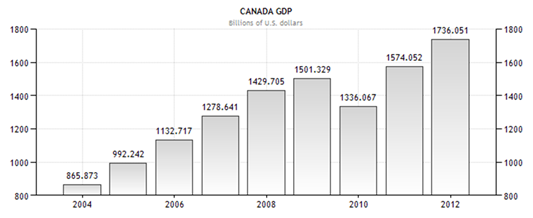
Canada GDP Growth Rate
The economic growth rate provides insight into the general direction and magnitude of growth for the overall economy.
Canada GDP Annual Growth Rate
The Gross Domestic Product (GDP) in Canada expanded 1.40 percent in the first quarter of 2013 over the same quarter of the previous year, reported by the Statistics Canada.
Historically, from 1962 until 2013, Canada GDP Annual Growth Rate averaged 3.3 percent reaching an all-time high of 8.8 percent in March of 1962 and a record low of -3.7 percent in December of 1982.
|
GDP | STATISTICS
|
Last
|
|
Previous
|
Highest
|
Lowest
|
Forecast
|
|
Unit
|
Trend
|
|
GDP Annual Growth Rate
|
1.40
|
Mar/2013
|
1.00
|
8.80
|
-3.70
|
1.12
|
Dec/2013
|
Percent
|

|
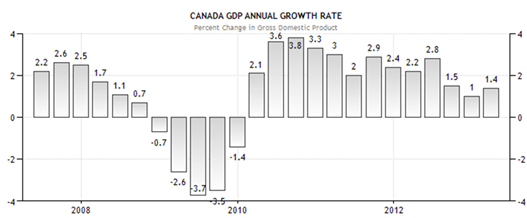
Canada Unemployment Rate
Unemployment Rate in Canada decreased to 7.10 percent in May of 2013 from 7.20 percent in April of 2013. Unemployment Rate in Canada is reported by the STCA - Statistics Canada.
Historically, from 1966 until 2013, Canada Unemployment Rate averaged 7.76 Percent reaching an all-time high of 13.10 percent in December of 1982 and a record low of 2.90 percent in June of 1966.
|
Labour | STATISTICS
|
Last
|
|
Previous
|
Highest
|
Lowest
|
Forecast
|
|
Unit
|
Trend
|
|
Unemployment Rate
|
7.10
|
May/2013
|
7.20
|
13.10
|
2.90
|
7.30
|
Dec/2013
|
Percent
|

|
|
CALENDAR
|
Event
|
Reference
|
Actual
|
Previous
|
|
08/Mar/2013
|
Unemployment Rate
|
Feb 2013
|
7%
|
7%
|
|
05/Apr/2013
|
Unemployment Rate
|
Mar 2013
|
7.2%
|
7.0%
|
|
10/May/2013
|
Unemployment Rate
|
Apr 2013
|
7.2%
|
7.2%
|
|
07/Jun/2013
|
Unemployment Rate
|
May 2013
|
7.1%
|
7.2%
|
|
05/Jul/2013
|
Unemployment Rate
|
Jun 2013
|
|
7.1%
|
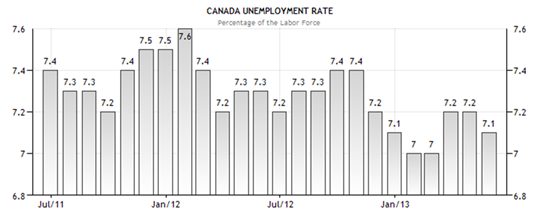
Inflation Rate
The inflation rate in Canada was recorded at 0.40 percent in April of 2013. Inflation Rate in Canada is reported by the Statistics Canada.
Historically, from 1915 until 2013, Canada Inflation Rate averaged 3.23 percent reaching an all-time high of 21.60 percent in June of 1920 and a record low of -17.80 percent in June of 1921.
|
Prices | STATISTICS
|
Last
|
|
Previous
|
Highest
|
Lowest
|
Forecast
|
|
Unit
|
Trend
|
|
Inflation Rate
|
0.40
|
Apr/2013
|
1.00
|
21.60
|
-17.80
|
0.55
|
May/2013
|
Percent
|

|
|
CALENDAR
|
|
Event
|
Reference
|
Actual
|
Previous
|
|
22/Feb/2013
|
|
Inflation Rate YoY
|
Jan 2013
|
0.5%
|
0.8%
|
|
27/Mar/2013
|
|
Inflation Rate YoY
|
Feb 2013
|
1.2%
|
0.5%
|
|
19/Apr/2013
|
|
Inflation Rate YoY
|
Mar 2013
|
1.0%
|
1.2%
|
|
17/May/2013
|
|
Inflation Rate YoY
|
Apr 2013
|
0.4%
|
1.0%
|
